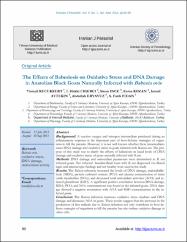The effects of babesiosis on oxidative stress and dna damage in anatolian black goats naturally infected with babesia ovis

Göster/
Erişim
info:eu-repo/semantics/openAccessTarih
2014Yazar
Küçükkurt, IsmailCiğerci, I. Hakkı
İnce, Sinan
Kozan, Esma
Aytekin, Ismail
Eryavuz, Abdullah
Fidan, A. Fatih
Üst veri
Tüm öğe kaydını gösterÖzet
Background: A reactive oxygen and nitrogen intermediate produced during an inflammatory response is the important part of host-defense strategies of organisms to kill the parasite. However, it is not well known whether these intermediates cause DNA damage and oxidative stress in goats infected with Babesia ovis. The purpose of this study was to clarify the effects of babesiosis on basal levels of DNA damage and oxidative status of goats naturally infected with B. ovis. Methods: DNA damage and antioxidant parameters were determined in B. ovis infected goats. Ten infected Anatolian Black Goats with B. ovis diagnosed via clinical signs and microscopic findings and ten healthy were used in the study. Results: The Babesia infection increased the levels of DNA damage, malondialdehyde (MDA), protein carbonyl content (PCO) and plasma concentration of nitric oxide metabolites (NOx), and decreased total antioxidant activities (AOA) and reduced glutathione (GSH). A significant positive correlation between DNA damage, MDA, PCO, and NOx concentrations was found in the infected goats. DNA damageshowed a negative association with AOA and GSH concentrations in the infected goats.
Conclusion: The Babesia infection increases oxidative stress markers and DNA damage and decreases AOA in goats. These results suggest that the increases in the production of free radicals due to Babesia infection not only contribute to host-defense strategies of organisms to kill the parasite but also induce oxidative damage in other cells.

















